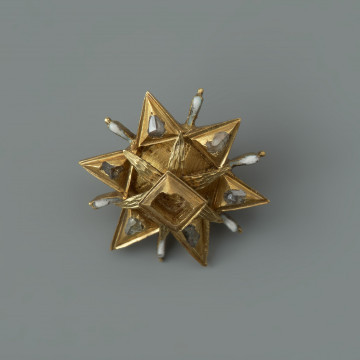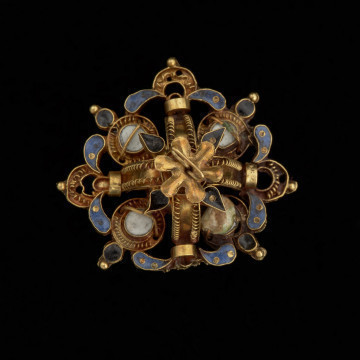
Star-shaped dress jewellery
nie po 1637
National Museum in Szczecin
Part of the collection: Jewels and costumes of Pomeranian dukes
John George I (1586-1656) took over as Elector of Saxony after the death of his brother Christian II in 1611. On this occasion, he founded a badge of honour with a black enamelled eagle. The badges, which the Saxon Electors presented to friendly dukes, aristocrats and high-ranking courtiers, were a sign of their recognition and special bond. Duke Francis I of Pomerania was in close contact with John George I through the Elector's sister Sophie, who became his wife in 1610. According to the Saxon archives, Francis I received a chain with a badge from his brother-in-law in 1613. The author of the jewel was the court goldsmith from Dresden, Gabriel Gipfel (d. 1617).The form and expression of John George I's jewel refer to Christian II's badge of honour. The oval badge is surrounded by a stubble wreath, a motif taken from the Electorate of Saxony's coat of arms. In the centre, there is a black two-headed eagle with a crown as a symbol of the empire, with the Electorate Saxony's coat of arms on its breast. In the frame around the eagle, there is an inscription SVB. VMBRA. ALARUM. TUARUM.1.6.11 (In the shadow of your wings 1611). On the reverse, a wreath with flowers held by two hands is depicted on the eagle's chest. This motif is repeated in the links of the chain. The inscription in the rim PRVS. MOR. QVAM. FIDEM. FALLIERE (Better to die than to break fidelity) emphasises the primary meaning of the jewel, namely, fidelity to the emperor.
Monika Frankowska-Makała
Author / creator
Dimensions
cały obiekt: height: 12 cm, width: 4,5 cm
Object type
pendant, jewellery
Creation time / dating
Creation / finding place
Identification number
Location / status

nie po 1637
National Museum in Szczecin

nie po 1637
National Museum in Szczecin

około 1600
National Museum in Szczecin
DISCOVER this TOPIC
Museum of King Jan III's Palace at Wilanów
DISCOVER this PATH
Educational path